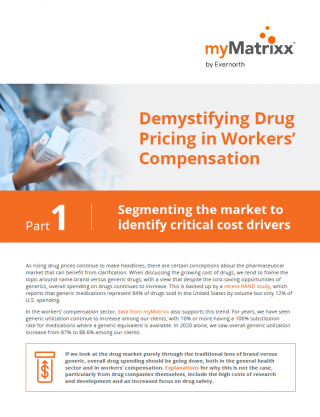As rising drug prices continue to make headlines, there are certain conceptions about the pharmaceutical market that can benefit from clarification. When discussing the growing cost of drugs, we tend to frame the topic around name-brand versus generic drugs, with a view that despite the cost-saving opportunities of generics, overall spending on drugs continues to increase. In the workers’ compensation sector, data from myMatrixx supports this trend.
Discover three market segments driving pharmaceutical spend and learn how to control claim costs.
For years, we have seen generic utilization continue to increase among our clients, with 10% or more having a 100% substitution rate for medications where a generic equivalent is available. In 2020 alone, we saw overall generic utilization increase from 87% to 88.6% among our clients.
If we look at the drug market purely through the traditional lens of brand versus generic, overall drug spending should be going down, both in the general health sector and in workers’ compensation. Explanations for why this is not the case, particularly from drug companies themselves, include the high costs of research and development and an increased focus on drug safety.
However, segmenting the drug market into categories beyond purely brand versus generic drugs enables us to more accurately identify the major trends and drivers for drug prices in workers’ compensation. It is possible for drug spending to decline even when drug prices are increasing based on enhanced patient outcomes resulting from clinical pharmacy management and changes in claim counts and injury severity.
In part one, we will provide an overview of three of the most important market segments driving pharmaceutical spending: the specialty drug market, compounding and physician dispensing. Coming soon for part two of this report, we will examine the overall pharmaceutical market looking at trends impacting price and utilization.
These three categories are a major source of high drug spending, but they do not receive the same level of attention as traditional name-brand drugs. While most workers’ compensation payers may not experience all three of these trends in their pharmacy portfolio, any one of them can have a dramatic impact on overall spending even as claim counts decline. Understanding these segments and how to appropriately manage them should be a key component of any cost-savings strategy in today’s drug market.

